Chickasaws Visit President Washington (1794)
By Richard Green, tribal historian (Published July 2009: The Chickasaw Times, printed in ushistory.org by kind permission)
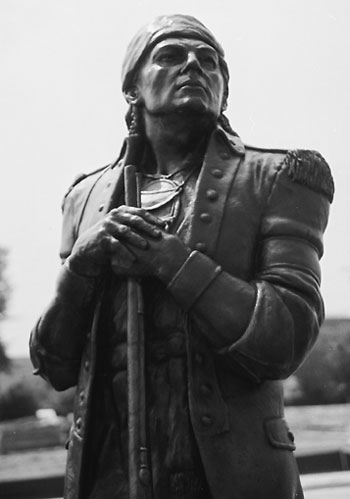
William N. Beckwith, sculptor
Fair Park, Tupelo, Mississippi
At noon on July 11, 1794, a group of Chickasaws, including Chiefs Piomingo and George Colbert, arrived at the President's House in Philadelphia for a welcoming ceremony hosted by President George Washington. (Philadelphia was the United States capital 1790-1800 while Washington, D.C. was under construction.)
The President's House was on Market Street one block north of Independence Hall, where the Declaration of Independence was adopted in 1776 and the U.S. Constitution was drafted and signed in 1787. The house was demolished in the 1830s, about the time that the Chickasaws were being removed to Indian Territory.
My source of information on the description of the President's House in 1794 is Edward Lawler, Jr., the Philadelphia historian who has researched and written extensively about its history for the Independence Hall Association (IHA).
I corresponded with him and then in May met him on the site of the President's House for an interview and "guided tour." The IHA and city of Philadelphia have collaborated to preserve the site and will construct a full-sized floor plan of the house with its foundations displayed for public viewing in glass encased subterranean chambers
Inside the three-story residence, Lawler said, Washington typically greeted important guests in the State Dining Room which he recently had improved for that purpose with the addition of a large semi-circular bow window. Washington would greet visitors standing with his back to the bow window, thus backlighting him, at six feet two, in rather a commanding manner.
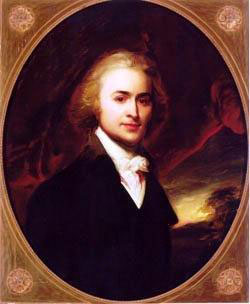
Museum of Fine Arts, Boston
Following the presidential greeting, ceremonial smoking likely was held in an even more elegantly appointed and impressive space, the Hall. Because it was framed on one end by a magnificent two-tiered mahogany staircase, the room's ceiling towered an estimated 38 feet above the floor. With the President were almost certainly Secretary of War Henry Knox (who was responsible for Indian affairs), and 28-year-old John Quincy Adams, the son of Vice President John Adams.
The up-and-coming young diplomat and future U.S. president had been invited by President Washington to attend the reception and meeting with the Chickasaws. It is lucky for us that young Adams attended because he wrote an unusually descriptive account (for the 18th century) of the meeting. Some 215 years later, I put his July 11th diary entry in the context of the time.
Background
In the 1780s, Chickasaws were divided over whether to ally with the Spanish colonialists or the fledgling United States. Chief Piomingo signed a treaty of alliance with the United States at Hopewell, S.C., in 1786 while another strong and well-respected chief, known variously as Ugulayacabe or "Wolf's Friend," signed a treaty with Spain at Mobile in 1784.
For a time, both chiefs also did business with their apparent adversaries, in what was probably a strategy of playing one nation against the other to enhance trade deals to benefit the tribe. But by the late 1780s, Piomingo was resolutely pro-American and anti-Spanish. Part of his resolve stemmed from the fact that Spain's staunchest ally and America's fiercest foe was the principal chief of the Creeks, the mixed blood Alexander McGillivray.
In 1787, McGillivray demanded that the Chickasaws expel American agents. When that didn't happen, the chief sent raiding parties to harass or kill Chickasaws and their American guests. One such raiding party in 1789 killed Piomingo's brother and nephew, who was carrying a message from Piomingo to the recently inaugurated President George Washington.
Unable to retaliate because of a shortage of ammunition, Piomingo asked the Spanish for arms. When Spain refused, Piomingo sought to meet with Washington in New York City. Bad weather or perhaps an unfavorable sign from the spirit world prevented the trip there, so Piomingo turned to the state of Virginia, which complied with the request that permitted the Chickasaws to strike back against the Creeks.
Meanwhile, President Washington had been unresponsive to Chickasaw requests for more aid until Piomingo and fifty warriors volunteered in 1791 to help the young republic deal with several tribes of northern Indians who wanted to keep the U.S. off their lands.
While it may seem ironic that Chickasaws would be aiding the United States to invade sovereign tribal land, Piomingo felt he had no choice. To defend themselves from Creek attacks, Chickasaws needed shipments of arms from the Americans, and the only way to secure them, Piomingo believed, was to demonstrate loyalty to the Americans. Furthermore, some of the northern tribes had been enemies of the Chickasaws through much of the 18th century.
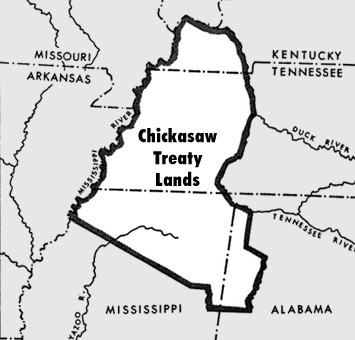
President Washington confirmed these territorial boundaries at his 1794 meeting with the Chickasaw delegation.
At the 1792 Nashville Conference, Chief Piomingo described the boundaries of the Chickasaw tribal lands:
"It begins on the Ohio at the ridge which divides the waters of Tennessee and Cumberland, and extends with that ridge eastwardly as far as the most eastern waters of Elk River; thence to the Tennessee, at an old field, where a part of the Chickasaws formerly lived, this line to be so run as to include all the waters of Elk River, thence across the Tennessee and a neck of land to Tenchacunda Creek, a southern branch of the Tennessee, and up the same to its source; then to the waters of Tombigby, that is, to the west fork of Long Leaf Pine Creek, and down it to the line of the Chickasaws and Choctaws, a little below the trading post." (Source: James Henry Malone, The Chickasaw Nation: A Short Sketch of a Noble People (Louisville, KY: John P. Morton & Company, 1922), p. 342.)
Loyalty mattered to Washington, who showered gifts on Piomingo and the warriors who accompanied him. In 1792, the Americans invited the Southern tribes to a council and peace treaty signing in Nashville. Tennessee territorial governor William Blount told the assemblage of tribes that Spain would demand land cessions but that the U.S. would not. "The United States have lands enough," Blount said, in one of the earliest and most erroneous predictions in American history.
Moreover, the Chickasaws were told that their blood and the blood of the Americans "was the same," meaning one would always defend against attacks made on the other. And in fact, the Chickasaws had struck against the Creeks when they had attacked American settlers in the Cumberland Valley.
That same year, Spain invited the Southern tribes to New Orleans to receive gifts and sign a peace treaty. One of the attendees was the Chickasaw king, Taski Etoka, who began receiving a Spanish retainer. McGillivray again signed with Spain and Creek raids on the Chickasaw increased. This time, when Piomingo asked for more American aid, it was promptly shipped to Chickasaw Bluffs (today's Memphis, TN).
As a result, the pro-American Chickasaws launched successful counterattacks on the Creeks, who were further disadvantaged when the chronically ill McGillivray suddenly died in February 1793. The pro-Spanish Chickasaws and other tribes, meanwhile, signed the Treaty of Nogales with Spain late that year. It was an offensive/defensive alliance and provided for annual gifts and permanent Spanish Indian agents.
Through Governor Blount in April 1793, Piomingo asked the President for arms, ammunition, and corn to offset a series of crop failures due to drought. Blount said yes, but no delivery date was included. So Piomingo decided to make his request in person during the late summer of 1793. His party set off, probably from his home in Chukafalaya (Long Town), intending to remind Washington of the promises made to the tribe at Nashville in 1792 by Secretary Knox. However, the Chickasaws met Governor Blount, who induced them to return home as deadly fevers were sweeping through Philadelphia.
In 1794, Piomingo felt even more urgency to see the President and made another request. Ugulaycabe had given the Spanish permission to build a fort on the Mississippi River at Chickasaw Bluffs, which had long been an important military position in Chickasaw country. Then, Ugulayacabe built a settlement nearby from which they could protect the Spanish from Piomingo's faction should those warriors attack.
Realizing the seriousness of the situation, Governor Blount was authorized to notify Piomingo that Washington would see him. Piomingo, George Colbert, and other unnamed chiefs and warriors set off and arrived in Nashville in June. In July, the Piomingo contingent arrived in Philadelphia — the largest American city with a population of about 35,000.
Piomingo and George Washington Meet

Published historical accounts of the meeting are perfunctory, recording the gist of President Washington's brief speech. But, apparently unknown to those historians, John Quincy Adams had taken quill in hand and recorded observations in his diary.
He wrote that the Chickasaw party included five chiefs, seven warriors, four boys, and an interpreter. Judging from the size of previous traveling parties to Philadelphia or New York, there were probably others who, for reasons of space, were not present in the room. Adams identified only Piomingo, about age 47, by name, but there is good reason to believe that long-time tribal interpreter and confidant Malcolm McGee was present, as was 30-year-old Chief George Colbert, also known as Tootemastubee. It is likely that mixed blood chief William Glover and Mucklesa Mingo were also present, as both had attended the Nashville Conference of 1792.
This blend of full bloods and mixed bloods reflected the transition of tribal leadership. In less than five years, the transition would be accelerated with the death of Piomingo. At a time of increasing contact with Americans, the Colbert brothers, George, William, and James, the sons of a white man (James Colbert) would become the leading chiefs of the tribe.
The Chickasaw boys Adams mentioned probably were the sons of chiefs selected by their families to be taught English by Americans. Washington made the offer during the meeting, but it isn't known if these boys remained behind to begin their education.
Despite the summer heat, the chiefs must have felt the need to demonstrate their loyalty graphically. Adams wrote that some were dressed in "coarse jackets and trowsers, and some in the uniform of the United States." Some of the party had shirts, others had none. No one, he noted, was "painted or scarified" and four or five had "rings in their noses."
He also noticed that "one or two had large plates [gorgets], apparently of silver, hanging upon the breast..." Piomingo and George Colbert had received peace medals in 1792 from Washington through secretary Knox, so these might have been them. But if these were peace medals, Adams probably would have identified them as such.
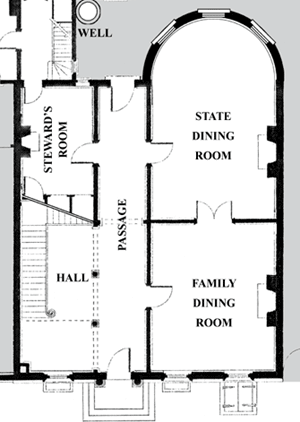
The ceremonial smoking of a peace pipe featured a decidedly odd twist. Instead of the usual clay or stone hand-held variety used by Chickasaws and most Indians, this one, according to Adams, was of "East Indian" origin, made of leather and was a gargantuan 12 to 15 feet in length. Washington took a couple of puffs, then passed the "tube" to Piomingo and so on around the circle.
Adams noted that the Chickasaws "looked as if they were submitting to a process in compliance with our custom. Some of them ... smiled with expressions that reflected "novelty" and even "frivolity," as if the "ceremony struck them ... as ridiculous."
President Washington then read his speech, which probably had been written by secretary Knox. Adams noted that Washington stopped at the end of each sentence for the translation. And Adams wrote that following each translation, the translator would repeat the same word twice, which he wrote sounded like "Tshkyer!" The five chiefs would then utter a sound that "resembled a horse's neighing" and that it would be faint or strong according to the "degree of satisfaction."
I contacted John Dyson for help making sense out of these utterances. He works for the tribe in the language revitalization program, and after some research and thought, replied that "Tshkyer" was Aaschishki, meaning, "truly this is what is being said." As for the neighing sound, Dyson interpreted that to be "_I_ i." In colloquial English, he said this means, "Uh-huh."
The President's speech is part of his official papers that are housed at the Library of Congress. Washington told the Chickasaws that their actions in support of the American Army against the hostile tribes northwest of the Ohio [in 1791] are the "strongest evidence of your friendship." If the Chickasaws "will join their arms with ours" the United States will "defray all the expenses upon a liberal scale." He said to communicate tribal needs "to the Secretary of War who will furnish you with Goods for your nation, your families and yourselves."
As added inducements, Washington told them if they wanted to continue on to see New York City, he would make the arrangements for their accommodations. And as noted, Washington said the United States would also provide for the education of willing Chickasaw boys. Meanwhile, he told them "to consider yourselves as at home."
This suggests that they might have been accommodated at the President's House at least for the night. But Ed Lawler believes it is unlikely: "I've never found references to guests other than family and close friends staying overnight at the President's House during Washington's administration. The upstairs' rooms were mainly occupied by family and staff, he said. On the other hand, the main house was approximately 9,000 square feet in size, and contained several rooms on the second and third floors that had been used as bedrooms, according to Lawler.
Adams continued by reporting that after Washington concluded his speech, Piomingo announced that he wasn't feeling up to speaking, but promised to do so in the next few days. Those meetings, Lawler said, would typically have been conducted at the offices of the war department in a recently constructed building aptly called the New Hall, which still stands today.
Finally, as wine, punch, and cake were served probably in the Family Dining Room, Adams heard Washington tell a group of the Chickasaws that they had always been "sincere and faithful friends" and that the U.S. valued them "most highly." Washington waited for a response, but according to Adams, they "made no answer to the President's compliment."
Postscript
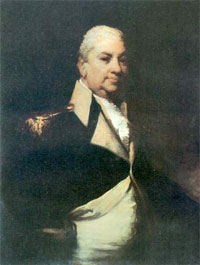
Meetings were held periodically over the next 10 days, but no details are known. A final meeting was held between the President and Chickasaw chiefs at 11 a.m. on July 21. Henry Knox submitted a farewell speech for Washington's review, but no copy of it is known to exist. Nevertheless, we do know that at that meeting President Washington commissioned one of the chiefs as a captain in the militia and gave the delegation many gifts.
The information comes via Ugulayacabe, who wasn't there but discussed the trip with some of the participants when they returned home. The gifts included either $600 or $1,000 (that's $12,000 to $20,000 in today's money) to Piomingo (the sum was in dispute), clothing and boots for everyone, and presents for their families and for persons named by Piomingo but who were not present. Each Chickasaw received $30 to use for purchases in Philadelphia stores.
At the request of the Chickasaw chiefs, Washington gave Piomingo a written document, setting forth the boundaries of the Chickasaw territory. These coincided exactly with those expressed by Piomingo at the conference in Nashville in 1792. The document stated that the Chickasaw territory was under the protection of the United States and included a warning to its citizens.
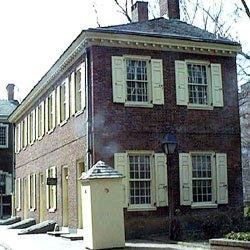
New Hall (reconstructed), adjacent to Carpenters' Hall, Philadelphia. New Hall was built in 1791 to house the Department of War offices. It is likely that the Chickasaws and Secretary of War Knox negotiated here.
They were forbidden to trespass on, injure, or molest Chickasaw persons, lands, hunting grounds, or other rights or property. They were also forbidden to purchase or treat (trade) with the Chickasaws for the title or occupation of any lands held or claimed by them. Washington also said he would "call upon all appropriate citizens to aid and assist in the prosecution and punishment, according to law, of all persons who shall be found offending in the premises."
Piomingo probably couldn't have worded it any better. But in five years, Piomingo and George Washington were both dead and five years after that, the Chickasaws were forced to make their first substantial land cession to the United States. It was a slice of land, which became western Tennessee, northwest Alabama, and western Kentucky.
Chief George Colbert, who had been with Piomingo and George Washington at the meetings in 1794, signed the land cession treaty as the Chickasaw's principal chief. John Quincy Adams was a member of the U.S. Senate, which ratified the treaty in 1807.
Note: The centerpiece for this article was discovered by Baldwyn, MS resident Mitch Caver, who was searching online for references to Chief Piomingo and found this remarkable description of a meeting between the chief and President George Washington.
Sources:
- "Diary of John Quincy Adams, July 11, 1794." Housed at the Massachusetts Historical Society, Boston, MA. Excerpts from this diary are courtesy of the Massachusetts Historical Society.
- James Atkinson, Splendid Land, Splendid People.
- John Haywood, The Civil and Political History of the State of Tennessee.
- Clarence Edwin Carter, ed., Territorial Papers of the United States, Volume IV, Territory South of the River Ohio, 1790-1796.
- Edward Lawler, Jr., "The President's House Revisited," The Pennsylvania Magazine of History and Biography, Vol. CXXIX, No. 4 (2005).
- Edward Lawler, Jr., interview, May 11, 2009.
- David Hoth, associate editor, The Papers of George Washington, University of Virginia.




